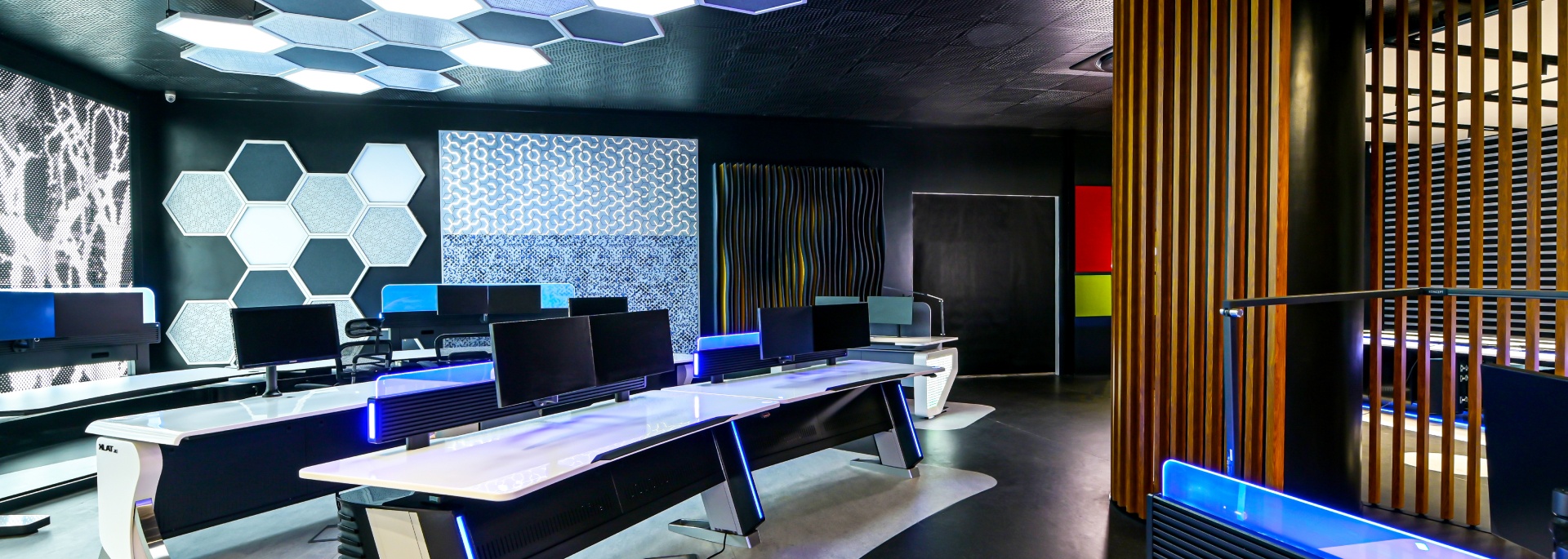
Control Room Consoles furniture are designed to provide ergonomic comfort to users while minimizing operational distractions so that they can focus on day-to-day operations. The task-specific furniture, desk, or workstation designed for mission-critical command centers is referred to as the Control Room Console. The built-in features of Control Desks such as motorized height adjustment for worktops, integrated cable management, CPU enclosures, and power & data outlets differentiate them from typical office furniture. These consoles are designed to empower the users, letting them concentrate on their work. It improves overall comfort & health that results in enhanced productivity. The design, orientation & its layout with respect to the Control Room determines its operational efficiency. Our design team collaborates with you to develop specialized solutions built on ergonomic excellence and human factors.
Our Featured Products
Xlat Xe
XLAT XE is a versatile command and control center console. Its adaptability provides best-in-class user experience, resulting in the effectiveness, efficiency, and better satisfaction of the operator.
Infi Xe
Infi Xe is the impressive novel solution. This space-efficient, robust & ultra-modern industrial Control Room Console provides seamless interface with technology to improve user experience
Xlat Cyber
Xlat Cyber is the newest edition to the XLATTM console family. It features next generation structure, attractive designer illumination, height adjustable features along with aesthetic styling than its predecessors
Dynamic Xe
The next generation console with integrated video wall is better known as Dynamic XE. Its elegant look and capability allow the user to handle all war like situations. All in all, it is a mini Control Room. Dynamic XE is reliable and fully configured to increase the efficiency of user to handle any mission critical control room environment.
Xtron
XTRON is the result of efforts to make the best even better. The organic design of the worktop and thermoformed side legs provides blithesome aesthetic appeal to the Control Console. Its natural drought mechanism provides efficient cooling without any fans, making it acoustically efficient.
Dynamic M
Dynamic M is a true representation of ergonomic operator desk. With its intelligent dashboard, this control room console adapts to every individual operator’s needs to perform with superior comfort and ease under scathing control room operations.
Xlat
Xlat Console gives the end-user, a complete control of the working environment. XLAT™ is designed to accommodate radical changes in technology, enabling the user with a flexible module to improve process efficiency.
Infi
With Infi’s trendy exterior, you can emphasize the individuality of your control console and demonstrate the appeal of contemporary designs. The outcome of the interplay between the various design elements is an extraordinarily impressive operator desk.
ATC Console
The ATC console plays a significant role in monitoring all the activities of the flights both in airspace as well as on the runway. The major scope of the ATC console is to optimize the overall takeoff and landing time and with zero risk of accidents. With the defined parameters of the ATC tower it also becomes necessary for the ATC console suppliers that the console equips the controller to have 100% visibility of runways and supports all defined actions without wasting even a fraction of second.
CENTER HUB
Pyrotech Workspace Solutions Center Hub presents a transformative approach to workspace organization through its modular design and customizable features, which cater to individual requirements. This innovative solution streamlines team collaboration and fosters innovation by centralizing meetings and discussions. Integrated technology and ergonomic furnishings prioritize productivity and comfort, ensuring an optimal working environment. Center Hub embodies adaptability, allowing users to tailor their workspace experience according to evolving needs. In essence, Center Hub represents a forward-looking solution for enhancing productivity and comfort in the modern workspace.
XLAT ZE
Its mono-pole design provides effective utilization of the available space. The covers & decorative trims of the leg can be easily removed by quick-release button and be replaced by new trims from a wide range of options to suit any kind of Control Room theme.
CONTROL ROOM CONSOLE SOLUTIONS
Our brand is rooted in India, yet its endeavor has led us to explore worldwide possibilities in ergonomic workplaces. With a journey of 18 years, PWS has served passionately installing 60,000+ control room consoles in over 30+ different countries including UAE, Australia, USA, Saudi Arabia, Bahrain, Qatar, Oman, Kuwait, South Africa, and many more. With our passion for delivering excellence in the field, we are formally known as "Control Room People," which complements our keen attempts to convey our excellence to every individual project we work upon. We also provide Production Control Room Services.
There are many challenges we faced, such as making the indoors of the control room healthier and Ergonomic Control Desk without compromising the functionality of the system set-up around. We underwent a deep study of ergonomic postures for the operators to design revolutionary control desks and sitting arrangements that can keep them in a decisive state of mind and body. We faced challenges of bringing automation under the comfort of human experience and driving the control towards solution-oriented efforts. PWS designed and invented the next generation of console desks to make them more dynamic in order to reduce the pain points of the operator. We offered expansion of the existing console reducing the cost of OPEX. We also introduced the up-gradation of single-tier monitors to dual-tier consoles without any need for fabrications and additional costs. By eliminating welded tops, we enhanced bodily comfort, making things ergonomically superior. We understand the difficulties of constant sitting and, at the same time, being super alert to respond the emergencies. Our convex and concave wall screen arrangement provides an optically user-friendly view that does not bother the operator despite the physical limitation of space availability. Our immense involvement in this journey has taught us precious learning about the expectations of operators and the need for their duties to perform day-to-day tasks. Considering the pain of the operator, PWS has summed up human anatomy, physiological factors, and engineering and architectural elements to mitigate the workspace limitations of human functionality. In efforts of a futuristic approach in the design of the CCR (Centre Control Room), Pyrotech has earned a reputation for providing healthier control room console furniture that results in the improved well-being of the users. For sustainable services and support (up to 20 years); PWS has introduced the SAP system to keep the provision of future modification in the least possible duration.

